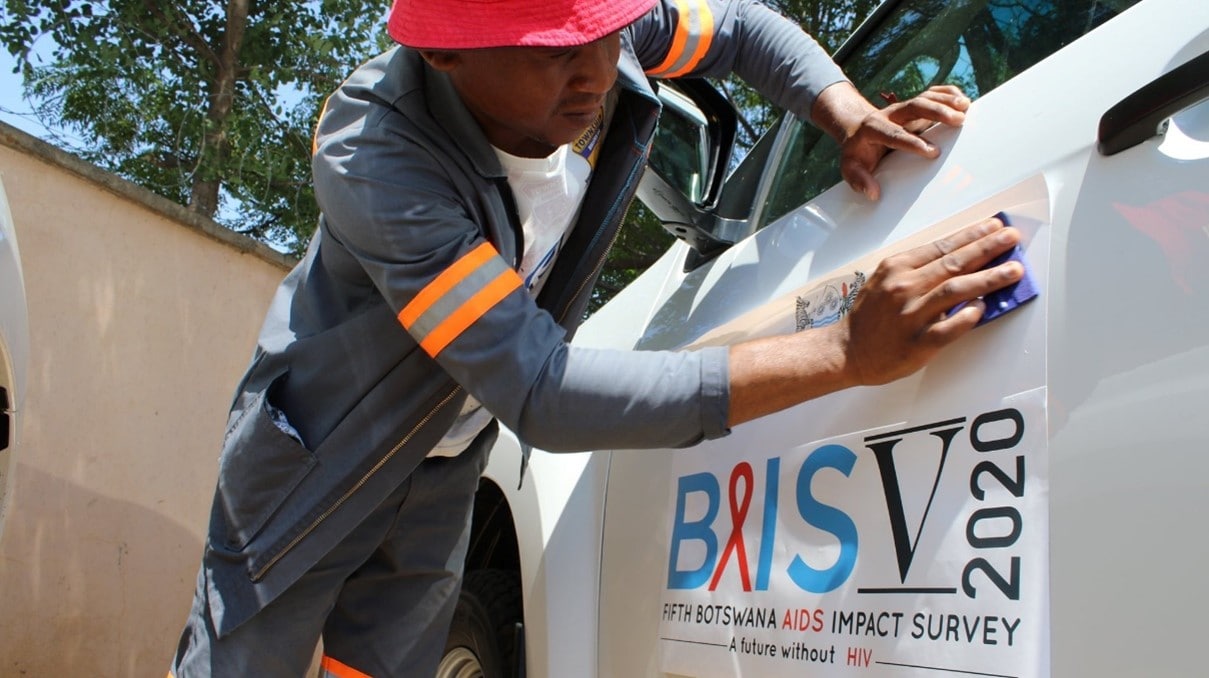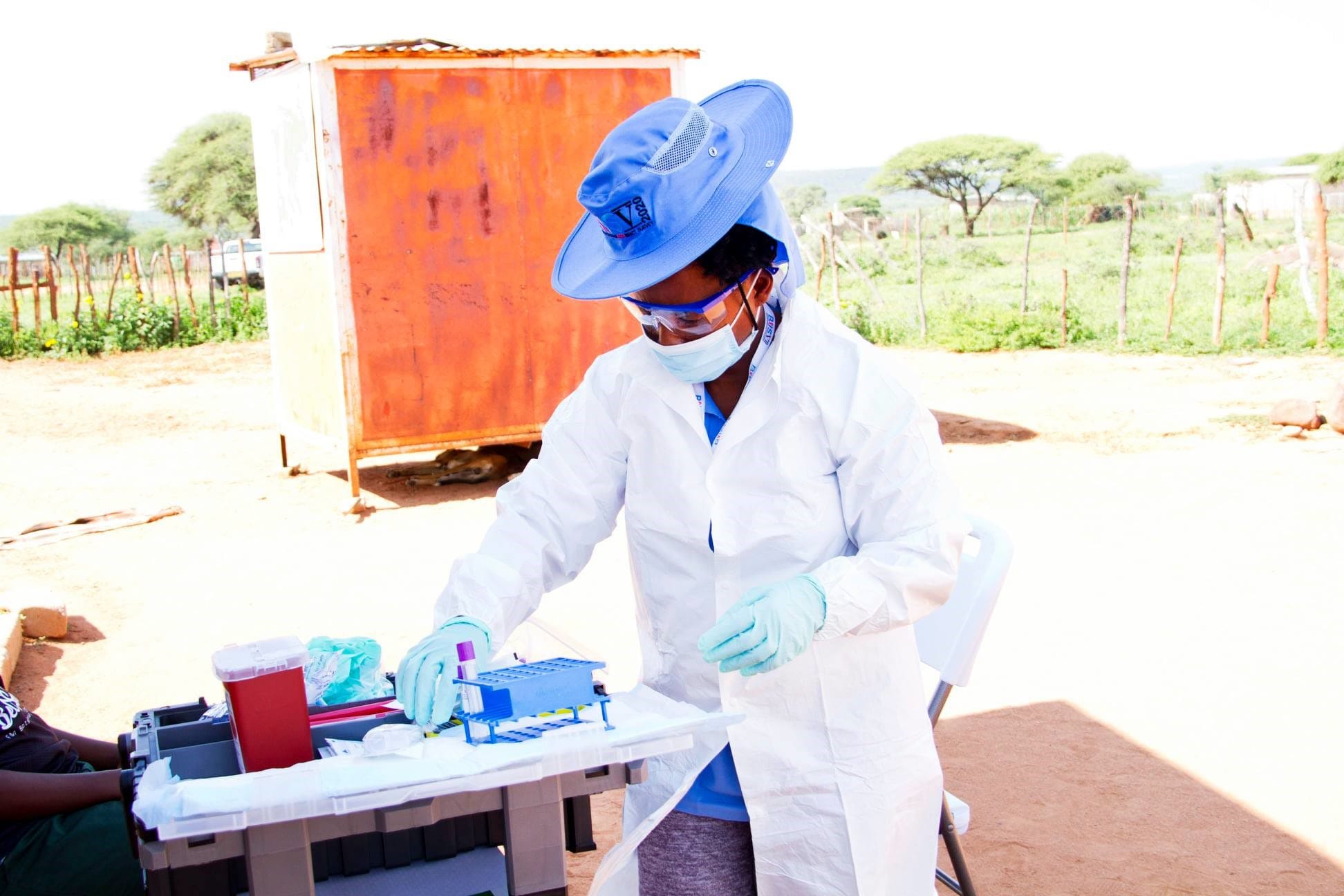At a glance
In 2022, results from a population-based HIV survey showed Botswana achieved UNAIDS targets for ending the epidemic four years early. These results show strong partnerships, commitment, and proven interventions can make a difference, even in a country with high HIV prevalence.

Achieving targets for ending HIV

Results from the Fifth Botswana AIDS Impact Survey (BAIS V) in 2022 showed Botswana achieved UNAIDS HIV targets, four years early. BAIS V is a population-based HIV impact assessment survey conducted in 2021. The survey is also the first to confirm the achievement of these ambitious targets. It was conducted by the University of Maryland Baltimore with funding from the U.S. President's Emergency Plan for AIDS Relief (PEPFAR). The U.S. Centers for Disease Control and Prevention (CDC) provided technical assistance for the survey.
According to BAIS V, 95 percent of people living with HIV (PLHIV) aged 15–64 years in Botswana reported knowing their status. Ninety-eight percent of people who knew their status were receiving antiretroviral treatment (ART). Ninety-eight percent of PLHIV receiving ART also achieved viral suppression – a reduction of the amount of HIV virus in the body.
In December 2021, Botswana also earned "Silver Tier" status from the World Health Organization. The achievement reflects lowered mother-to-child transmission rates, prenatal care, and ART coverage for over 90 percent of pregnant women with HIV. These achievements are remarkable for a country with one the highest HIV prevalence rates in the world. They also demonstrate that ending the HIV epidemic as a public health threat by 2030 is possible.
Ending HIV As a Public Health Threat by 2030
Enduring partnership leads to progress

Then CDC Botswana Country Director, Dr. Steven Hong, MD, MPH, reflected on the values that helped achieve these milestones. "These achievements did not happen overnight but are the products of commitment and partnerships. They also demonstrate the Government of Botswana's commitment to the health of its citizens and their partnership with CDC and PEPFAR."
CDC's partnership with the Botswana Ministry of Health (MoH) started with the formation of BOTUSA in 1995. BOTUSA [pronounced bah-too-sah], was formed to strengthen tuberculosis (TB) prevention and control through public health research. The partnership expanded beyond TB in 2000 to include HIV prevention, care, treatment, and strategic information services. These additional activities maximized the quality, coverage, and impact of Botswana's national response to the HIV epidemic. In 2002, Botswana created the first national HIV treatment program in Africa, called "Masa," meaning "a new dawn" in Setswana.
PEPFAR-supported programs in Botswana
The launch of PEPFAR in 2003 expanded HIV programming, with all U.S. government agencies collaborating with the MoH to end HIV. In 2016, Botswana's MoH adopted a "treat all" strategy to provide ART to all PLHIV who were citizens. Three years later, Botswana expanded access to HIV treatment to all PLHIV, regardless of citizenship.
CDC continued supporting HIV treatment when the BOTUSA program ended in 2014 by linking and keeping PLHIV in high-quality treatment programs. With PEPFAR support, CDC scaled HIV prevention services, including HIV testing, pre-exposure prophylaxis (PrEP), and prevention of mother-to-child transmission. CDC also scaled voluntary medical male circumcision and cervical cancer detection and prevention services for women living with HIV. Finally, CDC helped expand laboratory testing capacity for the diagnosis and care of PLHIV.
CDC also implemented DREAMS (Determined, Resilient, Empowered, AIDS-free, Mentored, and Safe) in Botswana. DREAMS is a public-private partnership tackling factors that make adolescent girls and young women vulnerable to HIV. CDC's continued support for strategic information activities in Botswana, including BAIS V, helps provide high-quality data for program monitoring and improvement.
Sustaining the impact
Having achieved ambitious UNAIDS targets for ending HIV, MoH focuses on sustaining this progress. This will require maintaining high-quality treatment services for PLHIV. It also requires expanding prevention services for key populations, adolescent girls, and young women who face greater risks for HIV infections. This can be achieved through evidence-based, equitable, person-centered HIV prevention and treatment programs. Programs can further sustain impact by fostering environments for increasing expertise among indigenous partners helping to build resilient public health systems.
To sustain the impact of its contributions in Botswana, CDC is increasing technical assistance and health system strengthening across programs. This will enable the MoH to continue providing services to all PLHIV and sustain HIV achievements long into the future. Technical assistance includes establishing a Clinical Mentorship Program to enhance staff capacity in MoH health facilities.
The Clinical Mentorship Program supports the provision of high-quality HIV services across the HIV care continuum at the facility level. Expanding continuous quality improvement (CQI) for targeted interventions will assist with continuity in treatment and provision of person-centered care. CQI is part of routine programming and is being integrated into the Clinical Mentorship Program. This will ensure accurate data are available at the facility level, with the capacity to interpret the data, supporting HIV programs. Clinical Mentorship Program and CQI have been implemented in all 27 health districts to support staff in MoH facilities.
Data-driven partnerships and interventions
CDC supports the implementation of recency testing in Botswana. This HIV testing innovation, developed by CDC helps distinguish between recent (within a year) and long-term HIV infections. Recent infection surveillance data is used to tailor HIV testing strategies and target effective treatment and prevention interventions, including PrEP. Recency data is used to identify clusters of recent infections and geographic areas with ongoing transmission and activate appropriate response measure.
MoH and CDC have reinstituted the Field Epidemiology Training Program to develop Botswana's public health workforce capacity. CDC also supported the MoH in developing the Botswana Public Health Institute. The institute will coordinate and support science-based leadership and expertise for sustained response to HIV and other emerging diseases.
CDC's support for MoH data systems help to enhance data completeness and quality, improve surveillance systems, and increase data use. CDC collaborates with the MoH to improve electronic medical records, strengthen local capacity for data analysis, and leverage BAIS V results. This data collaboration effort includes partners, such as The Global Fund, to ensure coordinated data technical assistance.
The Critical Role of PEPFAR Partnerships in Ending HIV
Looking to the future
MoH, CDC, and other partners are collaborating to achieve WHO "Gold Tier" certification for Botswana. This requires maintaining mother-to-child transmission rates of less than 5 percent. It also calls for increasing provision of prenatal care and ART to over 95 percent of pregnant women with HIV. Reaching this milestone will improve the standard of care for all women living with HIV in Botswana. It will also ensure that the next generation is born HIV free.
The partnership between MoH and CDC is dynamic and responsive to the trajectory of Botswana's HIV epidemic. Having achieved these ambitious UNAIDS targets for ending HIV, deeper cooperation is essential to sustain impact. PEPFAR and CDC continue to support Botswana's HIV treatment and prevention programs to sustain the impact of our collective efforts.
